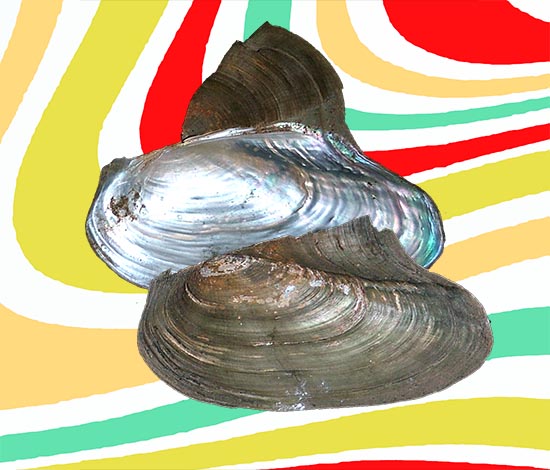| Page last updated
5 March 2017 |
Mussel of the Month
The March 2017 Mussel of the Month is Delphinonaias delphinulus. Delphinonaias is a genus of four species found in Central America.

MNHN. Marias du Rio Usumacinta, dans les Marecages du Yucatan [Mexio](type).
|
Delphinonaias delphinulus is another one of those Central American mussels about which we know very little. That is about all we can say when we honor mussels from that part of world in our monthly showcase (e.g., Psorula, Sphenonaias).
Delphinonaias caught our eye because it has been so unambiguously classified as a lampsiline since Simpson (1900). Even Martens (1900) — who was apparently unaware that Simpson was simultaneously moving mussel generic classification into the modern era — placed those mussels in Unio (Metaptera). Metaptera is a Rafinesque name for the genus Potamilus (also a Rafinesque genus). Presumably, these early classifications with Lampsilis and Potamilus were based on the alate* shape of Delphinonaias, but we wondered if anyone has actually looked at the anatomy. Does Delphinonaias exhibit the characteristic traits of the Lampsilini, like the marsupium limited to a portion of each outer demibranch and capable of expansion when gravid and long-term brooding?
There really aren’t that many references that mention the classification of Delphinonaias, and our quick scan of those did not produce an explicit description of the anatomy of D. delphinulus or any congener. However, Goodrich & van der Schalie (1937) came close. They lumped D. delphinulus under Leptodea paludosa and stated,
“On the whole, this species has all the characters of a Leptodea, both in soft parts and in shell characters.” (p. 47)
Leptodea (also alate*) is a lampsiline. Frierson (1927) and Haas (1969) even arranged Delphinonaias as a subgenus of Lampsilis. We recognized Delphinonaias as a genus (Graf & Cummings, 2007), and we will continue to do that until we have some data to the contrary.
-----
* Alate refers to the presence of hinge wings. |
|
Classification:
Phylum Mollusca
Class Bivalvia
Subclass Palaeoheterodonta
Order Unionoida
Family UNIONIDAE Rafinesque, 1820
Subfamily AMBLEMINAE Rafinesque, 1820
Tribe LAMPSILINI Ihering, 1901
Genus Delphinonaias Crosse & Fischer, 1894
Species Delphinonaias delphinulus (Morelet, 1849) |
To find out more about Delphinonaias and its classification, check out:
- Frierson, L.S. 1927. A classification and annotated check list of the North American naiades. Baylor University Press, Waco, Texas. 111 pp.
- Goodrich, C. & H. van der Schalie. 1937. Mollusca of Petén and North Alta Vera Paz, Guatemala. Miscellaneous Publications, Museum of Zoology, University of Michigan (34): 50 pp.
- Graf, D.L. & K.S. Cummings. 2007. Review of the systematics and global diversity of freshwater mussel species (Bivalvia: Unionoida). Journal of Molluscan Studies 73: 291-314.
- Haas, F. 1969. Superfamilia Unionacea. Das Tierreich, Leif. 88. Walter de Gruyter and Co., Berlin. 663 pp.
- von Martens, E. 1900. Biologia Centrali-Americana. Land and freshwater Mollusca. 675 pp.
- Simpson, C.T. 1900. Synopsis of the naiades, or pearly fresh-water mussels. Proceedings of the United States National Museum 22: 501-1044.
|